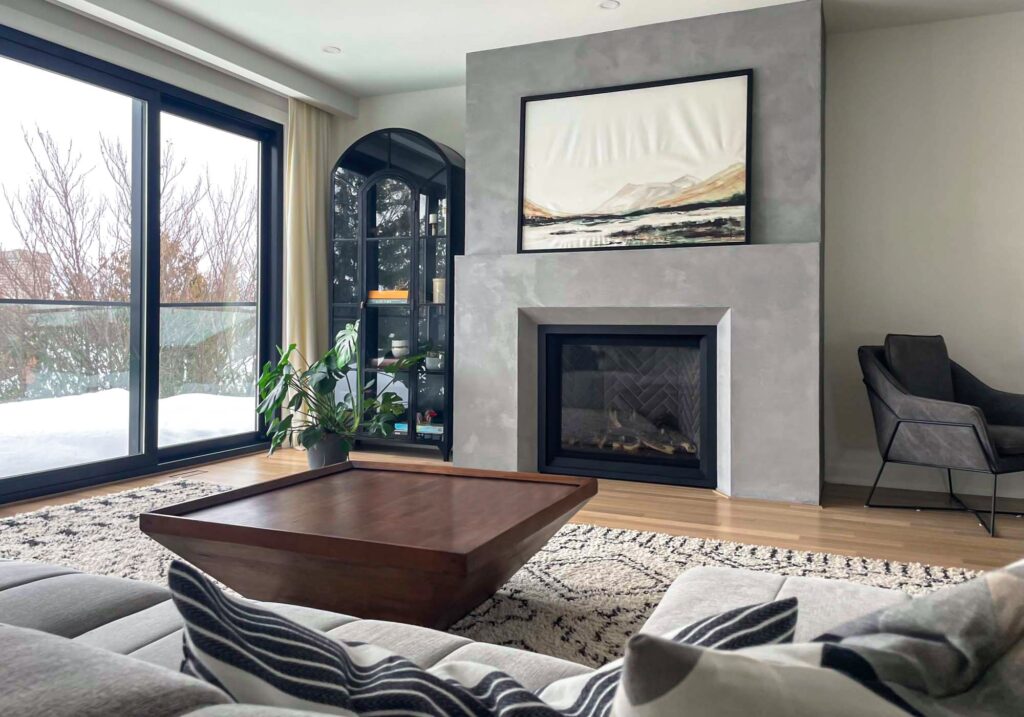
In this part, we will tackle the following frequent questions about microcement.
• What is microcement?
• How is microcement applied?
• Is microcement waterproof?
• How much does microcement cost?
• Can I use microcement in the bathroom?
• Can microcement be used on floors?
• Should I use Microcement or Venetian Plaster?
Let’s get in.
What is microcement?
Microcement is a decorative lime/cement plaster-like finish that is gaining popularity worldwide. The final finish might range from smooth stone wall designs to rough industrial cement feature walls and ceilings. Microcement may be used on floors, furniture, ceilings, and showers.
How is microcement applied?
A specially designed trowel is used to apply microcement. Not every application needs the same procedure, but generally speaking, the application proceeds as follows:
• Prepare the surface by patching, taping, and sealing it with priming sealer.
• Use a specialist microcement primer.
• Apply 2–3 applications of microcement.
• Sand the final finish (optional).
• Use several coats of specialized sealer (optional).
• Let the final finish cure.
The following is a simplified explanation of how microcement is used. Depending on the surface and desired appearance, microcement may have 2-5 layers. To avoid cracking, you may need to insert a mesh between the layers. In the sections that follow, we will go over the intricacies of each layer.
Is microcement waterproof?
Yes, it can be.
Microcement is very durable and water-resistant, therefore a waterproof sealant or the Schluter method is not always required. If you need to waterproof your microcement finish, you must always use a waterproof sealant and, in certain cases, use a Schluter method to prepare the surface.
Before applying microcement to the shower area, a waterproof barrier, such as a Schluter board system, highly recommended. The Schluter board system consists of specialist mortar and malleable waterproof sheets that are applied over cement board or moisture-resistant drywall. After applying the microcement to the Schluter systems, a sealer layer is still necessary.
The final coating of a specialist waterproof sealant is required for microcement bathroom walls and wet areas such as backsplashes. The sealer comes in a variety of sheens, including matte, satin, and glossy.
How much does microcement cost?
The square foot pricing for projects larger than 500 square feet varies from $20 to $35 per square foot. The wide variety is due to the fact that certain surfaces need more preparation, layers, and details.
The low-end $20/sq ft price is for huge surfaces like floors or large walls that are not limited by corners or height limits, such as towering walls that need scaffolding.
The $35/sq ft price is for sections such as showers that need numerous layers or ceilings, which are more difficult to install.
For projects under 500 square feet, fixed pricing vary from $4000-$8000 (perhaps less for narrow walls). We offer fixed costs for smaller projects since each one needs a minimum setup time and service fee to be viable.
Surfaces, design, durability, setup, needed preparation, and placement are all factors in a microcement project. We try our utmost to work within our clients’ budgets and provide alternate alternatives that may be less expensive or more effective.
The prices shown above represent our pricing methodology. Other businesses may have different pricing. Our prices reflect the high level of work we deliver.
Can I use microcement over tiles?
Yes. Microcement may be applied directly on tiles by placing customized mesh sheets between the first and second coats of microcement. Microcement may be applied over floor and shower tiles, saving you money and debris during renovations.
Microcement may be an inexpensive option to remodel showers and flooring with little demolition necessary. Instead of removing your walls and floors, you may use a contemporary smooth or rough cement finish in any hue.
Can microcement be used on floors?
Yes. Microcement flooring are both durable and contemporary. It may also be less expensive to lay microcement over existing tiles rather than removing and replacing them. To minimize cracking, consider adding a mesh between the first and second coatings.
Microcement flooring also provide a variety of designs, colors, and sheens. For example, you may have a rough-textured design with a matte shine or a smooth texture with a glossy sheen. If you pick a rough-textured pattern, you must apply the sealer layer with a heavy roller to ensure that it penetrates the textures.
The possibilities for adding microcement to floors are endless.
Examples of microcement flooring:
Over existing tiles at the front entryway.
Over the bathroom floor tiles.
Over aged, unpolished concrete flooring
On outdoor walks and patios
Should I use microcement or venetian plaster?
One of the most often asked questions is, “What’s the difference between microcement and Venetian plaster?” as an alternative to “should I use microcement or Venetian plaster?” . This article compares microcement to Venetian plaster. The choice between the two is determined on the functions and design you like.
Microcement is simple, modern, long-lasting, rigid once dry, and waterproof. Microcement does not allow for as much detail as Venetian plaster since it dries considerably quicker and only comes in one grain size.
Venetian plaster is natural, simple, intricate, detailed, and, in certain cases, durable and water-resistant. Venetian plaster cures more slowly than microcement, giving you more time to create or “draw” with the plaster. And since Venetian plaster comes in a variety of grain sizes, the varying textures allow you to add additional depth and complexity to the pattern.
Both Venetian plaster and microcement may be basic and contemporary. The main decision is whether you like more features and personalization (Venetian plaster) or greater durability (microcement).
If you need assistance planning your space and deciding on the appropriate finish, schedule a design appointment with us.
